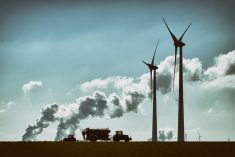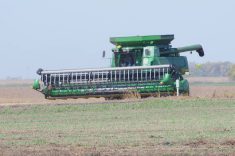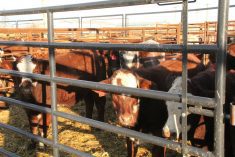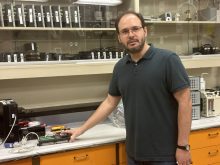People may have to change the way they work with animals if they want the world to have a sustainable future, a recent conference at the University of Manitoba was told.
The historical relationship between human beings and domesticated animals, which has lasted for ages, may now be too environmentally burdensome to cont inue, an Agr icul ture and Agr i-Food Canada research scient ist said.
As a result, this “ancient contract” may have to be rewritten, said Henry Janzen, an AAFC soil scientist stationed at Lethbridge, Alberta.
Read Also

Pig transport stress costs pork sector
Popular livestock trailer designs also increase pig stress during transportation, hitting at meat quality, animal welfare and farm profit, Agriculture and Agri-Food Canada researcher says
Janzen was the keynote speaker during a discussion on the topic “Livestock: Help or Hindrance in Renewing Earth?” The National Centre for Livestock and the Environment hosted the April 26 public meeting.
Janzen said the domestication of animals thousands of years ago “transformed the face of the planet” more than anything else in human history.
This symbiotic relationship benefited human beings, livestock and the earth itself. People cared for the animals, who in turn provided meat, milk and fibre while living in communion with the landscape.
Now, however, this ancient linkage between humans, animals and the land may be unravelling because of environmental concerns, said Janzen.
Activists frequently argue livestock endanger the environment because of the space they inhabit, the manure they shed and the gases they emit.
Farmers and industry people respond by saying livestock benefit the environment instead of harming it.
But activists’ criticisms are not completely unjustified, Janzen said, listing several ways livestock impose stress on the landscape.
For one thing, livestock can change the way the land is used and not always for the better. As an example, Janzen noted the deforestation of the Amazon jungle for cattle grazing.
Although manure is a good fertilizer, producing it is an inefficient use of nutrients. Janzen said little of the nitrogen consumed by animals ends as protein on the dinner plate. Over 60 per cent of the nitrogen in livestock feed is released into the air as ammonia. Studies indicate livestock are responsible for 18 per cent of all greenhouse gas emissions, said Janzen.
There’s also the feed-versus- food issue. Livestock consume grain that people might eat, although it’s usually feed grade and not suited for human use.
On the other hand, domestic animals contribute environmental benefits which are not always recognized, said Janzen.
Livestock preserve fragile grasslands which might otherwise be cultivated and subject to soil erosion. Grasslands also store carbon instead of releasing it into the air as greenhouse gases.
Cattle also recycle nutrients and turn inedible grasses into edible human food.
Livestock also provide social benefits, such as livelihoods, lifestyles and an “esthetic appeal” which goes beyond simple food production, Janzen said.
So are livestock a help or hindrance in preserving the environment? They’re both, Janzen concluded.
He said the ancient contract between man and animals will continue. But it will have to change.
Future livestock must be more in harmony with the land. It should be “prudently productive,” regenerative, resilient, diversified and ethically driven, Janzen said.
Panellists during a discussion following Janzen’s talk said livestock production can be sustainable and it sometimes gets a bad name unfairly.
Owen McAuley, a producer from McAuley, Manitoba, said negative public perceptions of livestock operations often stem from poor farm management, not from the animals themselves.
“We shouldn’t blame livestock for the fault of people,” said McAuley. [email protected]
———
“Weshouldn’tblame livestockforthe faultofpeople.”
– OWEN MCAULEY


















